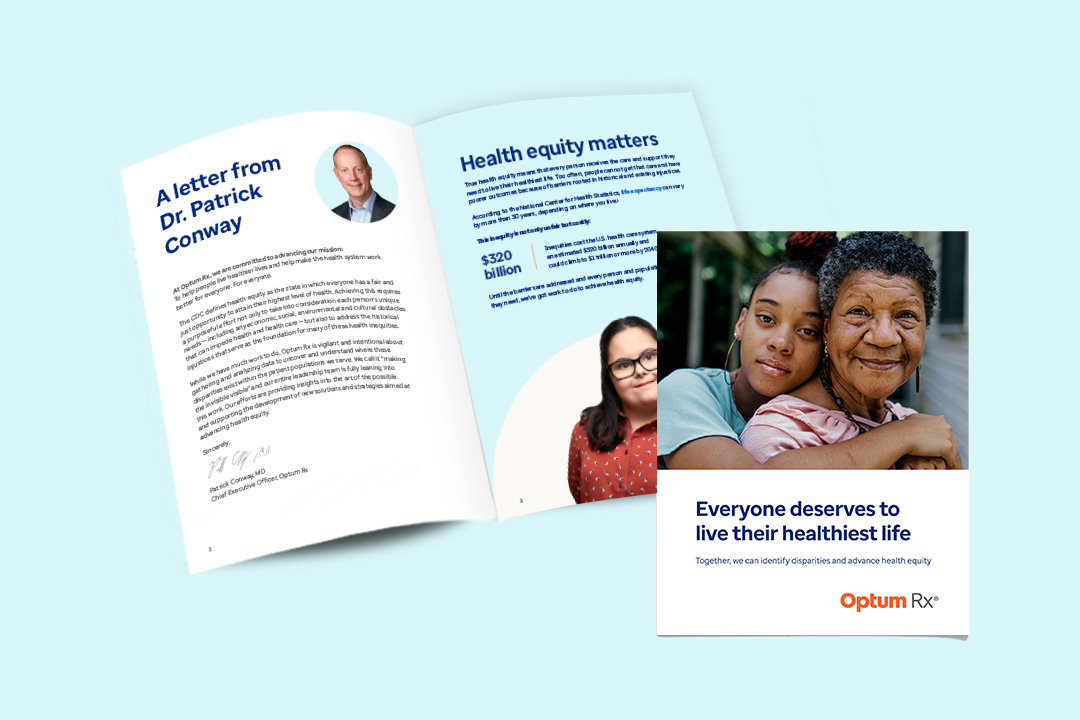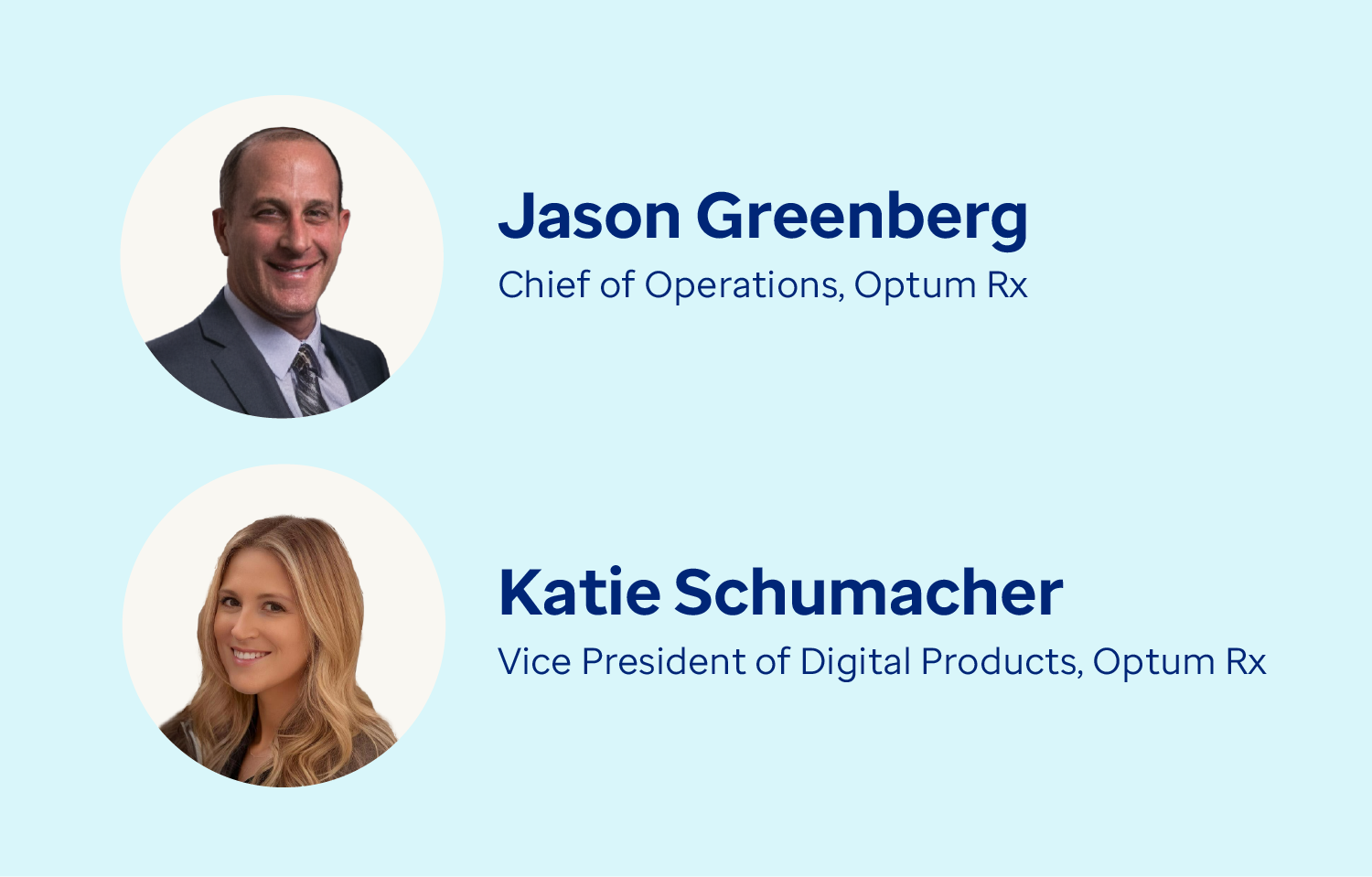Innovations with impact
While the operational side of pharmacy care services business rarely garners headlines, the efforts of operations teams are vital to making prescription medications accessible and affordable. Optum Rx Senior Vice President of Clinical Consulting, Scott Draeger, recently welcomed Jason Greenberg, Optum Rx chief of operations, and Katie Schumacher, vice president of digital products at Optum Rx to discuss how ongoing innovations in operations are helping to help improve the pharmacy benefit management experience for plan sponsors, providers, and members.
Read on for excerpts of their conversation below listen to this episode of the Pharmacy Insights Podcast here.
January 1 and creating a seamless digital experience
Scott Draeger: January 1st is a really important date in the world of PBM operations. I'm pretty positive that there's no one in this organization who can remember the last time they celebrated New Year's Eve. You know it's important for plan sponsors. It's important for members. Jason and Katie, can each of you give us a sense of how things went from your perspective?
Jason Greenberg: Jan. 1 is something I always used to reference as our Super Bowl, but it's really more of a marathon. It's a year-round process in which we get prepared for our January business.
This last Jan. 1 was really, really successful, and I’m really proud of the team. We had our highest volume of clients ever and had the least number of issues ever. We’re actually down 39% year-over-year and the number of issues we saw post go-live and that allowed us to close our command center earlier than ever. So, we have a very disciplined process around managing issues post Jan. 1, and, again, the volume was down so significantly that we closed earlier than ever.
In combination with highest volume and least issues ever, we also received incredible feedback from our clients. We had the highest NPS (net promoter score) we've ever seen at 69. And from a satisfaction perspective, we send out surveys and 99% of our clients were satisfied, and we met over 99% of our performance guarantees.
So really proud of the cross-functional team that supports these new clients or existing clients who are making changes on Jan. 1. Really just a successful year for us.
Katie Schumacher: I couldn't agree more. With digital being one of those cross-functional team members, I truly think this year was one of the most seamless I've seen because of that cross-functional collaboration and readiness that's happening end-to-end with our operations teams.
The other thing I'd add is it doesn't have to be such a disruptive season. We have an opportunity to shift left and start preparing earlier for what some of those upcoming changes are. Like with our onboarding experience, we actually saw that about 97% of our members felt prepared after receiving some of those onboarding communications ahead of that peak season.
We also saw just a remarkable digital adoption this year, and I think that really goes to show just where we're seeing the market head and where consumers are heading. So, by providing that data and information around actions a consumer can take, we were prepared to do that this year and I think that helped. And we saw that in the numbers and the growth in our digital assets. The mobile app alone was up 15% year-over-year.
Scott: That's fantastic. I know firsthand that getting implementation right is such a predictor of a future success, so that's really great to hear. I don't think anybody would argue that the health system was never really built as a system per se. Jason, what are you and the organization doing to connect some of those disparate parts and really simplify the experience for those members and plan sponsors that we serve?
Jason: You know, stitching these different experiences and systems together reflects our overall mission statement around helping people live healthier lives and helping the health care system work better for everybody. But really, we have to think about all the different constituents in the experience. If you think about it in silos, you don't solve the big problems.
A big shift for us over the last three years is really to think about things holistically, and how it all works together. So, you've got to consider our clients’ needs and then our members, our providers and our pharmacies. It all has to work.
Scott: Jason, I want to tease that out a little bit more. Can you drill into what that client perspective was? What are the latest innovations and solutions that we're working on for clients?
Jason: It all starts with our clients. They're the key decision-makers. And it's really exciting for me, thinking about the health care ecosystem in the pharmacy space. So, it all starts with our Optum Rx Client Central, and this is the ecosystem that we have across our various systems which empowers clients by connecting our industry-leading benefit capabilities. These include our RxClaim platform as well as our client portal.
RxClaim is at the center of it. The core of what we do is adjudicating claims and RxClaim is the industry leader in terms of the size, scale and volume that is processed from an adjudication perspective. We continue to invest in it to modernize it.
And then we surround that with all sorts of tools that help clients. We have a proprietary cloud-based onboarding system. We designed it thinking about a “TurboTax for Implementation.” What it enables us to do is plan-build automation. So, activities that used to take days or weeks to build benefits are now sort of push-button and take just minutes and allow us to have really high quality. We also leverage automation and technology for testing to ensure we have high quality and the outcomes clients expect.
Finally, we continue to invest in our client portal and the way in which we interface with our client. Later this year, we'll actually be introducing a new and improved version of our client portal, which is really one-stop shopping for them. This will allow them to access the various components of our ecosystem, submit issues and do the tasks that they need to do all in one place, as well as providing enhanced reporting.
Scott: Let's talk a little bit about the member experience. There's a patient behind every transaction. We know that consumer expectations have evolved over the years. Katie, what does interacting with their PBM or pharmacy look like to members new to Optum Rx in 2024?
Katie: Great question. I’ll tie it back to what Jason was talking about.
A lot of that automation that's happening earlier on with clients is enabling us to provide the consumer a better and more accurate experience further upstream. So, we do see less of that disruption on Jan. 1. Members and patients now expect to be able to manage things digitally. They expect to be able to make a phone call or go online, see consistent information, and really manage that like they do in every other part of their life.
We've also seen really good outcomes from members switching to digital. Digital promoters are 1.5 times less likely to cancel a prescription and are 8 times less likely to encounter an issue. We also see benefits for the continuity of care overall. A lot of investment has gone into our digital experience. So, consumers starting with that first experience with our PBM and pharmacies understand their coverage, understand their options and have that end-to-end experience.
We spent a lot of time over the last year, year-and-a-half redesigning all of the core parts of our digital experience across web and mobile and really doing a lot of cocreation with patients, with members, including user studies and co-design labs. And so we've seen just amazing outcomes. Again, as we look at what peak season was like last year compared to this year, we can see that in the data, that people are converting at higher rates. They're completing tasks faster and they're getting what they need — without having to dig around deep into the site.
So, it's just been incredible to see this organization’s investment into automation and the consumers’ digital experiences. And it's been incredible to see the outcome and the benefits: everything from continuity of care to prescriptions getting shipped at faster rates. It's been really fun.
Jason: It all starts with the member and their experience. That's what we anchor on. I think there's still opportunity for more adoption of the use of digital, especially in this space. As Katie walked through, we see better outcomes — the data shows that.
Now, our big push is to continue to educate our members about the “what's in it for me” and help them understand how they will have a better experience and outcomes through use of our digital ecosystem.
Improving pharmacy program accessibility and affordability
Scott: Jason, let’s stick with that focus on our members. What are some of the things that Optum Rx is doing to support members with accessibility and affordability?
Jason: Super excited to talk about this. It's at the core of what we do. Operations is always the back office, but what we talk about a lot is the why.
There’s a patient at the end of this, and what I'm really proud of is the culture we've created. The operations teams really wake up every day and understand that the work we do has real life implications for our members and consumers. When you think about accessibility, it's really about meeting the members where they are.
Again, Katie’s work is incredible for those who want to engage digitally, but one of the things we’ve introduced this year is a Spanish interactive voice response, or IVR. We have over 200,000 calls a year from folks who prefer speaking Spanish. So, we've created this IVR to help them, and we've seen massive increases in satisfaction in that population through the engagement in the Spanish IVR.
There's also a real focus on making drugs more accessible. Beginning in January of this year, Optum Rx placed 8 preferred insulin products on our standard formularies at Tier 1, ensuring that we're limiting the out of pocket spend for members to $35 or less.
And when I think about affordability for our members, one of the coolest programs we have is called Optum Savings IQ. It was actually funded out of our Health Equity program, but it's a new platform that enables our teams to see all of the saving opportunities for members for specialty drugs across co-pay cards, grants, foundations, manufacturer credit cards and other free drug programs.
Since we've deployed this, we've saved members over $1.5 billion, with over $800 million in financial assistance delivered just in 2023. And for 2024, we're on target to save our members over a billion dollars. Just as an example, for a patient that's on an autoimmune therapy, on average they saved over $10,000 annually. That's just amazing in terms of getting our members access to the drugs that they need at the lowest price.
There’s also Price Edge, which compares on-benefit versus cash or off-benefit prices and then provides the best price to the member. So, we're not just focused on what's on-benefit, we’re also scanning to see what's out there from a cash price perspective and giving the member the lowest cost possible. We have over 8 million members using Price Edge today and that's not something we charge for, that's something we do just to help our members. In 2023, we saved our members $30 million through this program, with a $47 average member savings per prescription. These are just a few of the different programs that we have to make drugs affordable for our members.
Katie: I absolutely love the topic of affordability and a lot of the things that Jason highlights. Our members expect transparency. They expect flexible options. And programs like Price Edge — as well as some of the things that we’ve enabled both digitally and through our IVR — have really shown our consumers that we can provide that level of flexibility. We've really seen an improvement in our consumer sentiment around that area.
Scott: Jason, let's move to another vital stakeholder in this whole equation, and that's providers. Are we seeing a similar shift to these modern digital tools in how we're partnering with these providers?
Jason: The provider experience is really critical in relation to the member experience. They really go hand-in-hand, and so we've leaned into that the last few years.
Of the two areas I think about, one is prior authorization (PA). That is one of the key areas in which we interact with providers. Specifically, we want to simplify the process through the tools that they already use, such as the EHR or EMR, the electronic health record or electronic medical record.
When I think about it in those two dimensions from a prior authorization (PA) perspective, we're an industry leader in terms of how we interact with providers. Over 84% of our PAs are submitted electronically, also called ePA, and of those, two thirds are fully automated approvals. That sort of removes the abrasion and the lift from the provider’s perspective.
As I said, we're really leaning into that EHR integration and leveraging the data that's available. PreCheck MyScript is not a new tool but a tool we were the first to bring to market and we continue to invest in. It's embedded in the provider workflow and allows them to check benefit and formulary info for a specific member. And when we see providers use that tool, patients save on average $119 per script and plan sponsors save $266. We also see a 16% switch rate, meaning the provider moved from one drug to another based on the information that was provided to them.
Last year, we sent out a million and a half reminders to providers to start the process sooner when we have PA renewals. We want to take a more proactive approach to PA and avoid any access-to-care issue, and so we've really leaned into that communication approach.
We're also partnering with our clients. There's an opportunity — when clinically appropriate — to automatically extend prior authorization. So, instead of making the provider and the member go through a renewal process, when it makes sense, we're able to automatically extend those PAs. We did that for over 750,000 prior authorizations last year. That totally eliminates the abrasion altogether.
What’s next with Optum Rx innovation and capabilities
Scott: Last question for the both of you. It's pretty simple: What's next? What new capabilities have you excited? What do you guys think people should be aware of as we continue to innovate? Katie, I'm going to start with you.
Katie: Absolutely. Gosh, there's a long list here. As we look at just really over the next year and where we need to focus, one of the top-of-mind things for me is continuing to expand across channels. That means making those connection points across channels, doing more native integrations with things like our mobile app and leveraging the power of the camera, of the geolocation to know where somebody is and where they may find that best price.
Another priority is personalization and just really knowing who our consumer is and teeing up personalized and configured experiences for them. And lastly, just enabling choice for consumers, allowing them to kind of tell us where and how they want to be communicated with, where they want to engage, what's relevant and important to them so that we can really craft the right experience.
Jason: This is probably the area that is the most exciting to me. I have a dedicated team focused on innovation.
Just a couple of examples. I talked about the PA space and integration with the electronic health record. We also have a pilot program underway where we're able to leverage technology to reach into the EHR and gather all the information that's needed for a prior authorization. Essentially, we can process the prior authorization within a few seconds. So instead of the traditional submission/rejection and resubmission of information, this allows us to use the data that's already available within the medical record to have the PA processed in seconds. If you think about that from a provider workflow perspective, it lessens the work they have to do, and from a member perspective, they're getting their PA approved almost in real time.
There are other things where we're using AI, and we’re really excited about this. We're really trying to shift from being reactive to proactive. We have another pilot we're working on right now where we've identified certain scenarios or data that is predictive of an issue that will happen later, things like out-of-stock medications or in particular focusing on lifesaving and life-sustaining medications. We can use AI to predict when a member may have an issue and then proactively reach out to them to address it before it ever happens. This is again something we're piloting right now, but I'm super excited about. How do we leverage data and technology to help our members and avoid issues altogether?
Finally, I'll mention our new integrated pharmacy in Mesa, Arizona. We rolled that out last year, and it really harnesses AI and automation. They have a team of engineers who are some of the smartest people I've ever met. We have over 20 patents pending in use there that help us drive scale and quality.
Just as an example, we're using AI to take pictures of every pill bottle and examine the pills inside and compare them to images. This makes sure that we've got the correct pill with the right color, or the right size, and make sure it's not broken.
We're now distributing over 200,000 scripts per day with quality over 99.999%. So, we are leveraging technology both for scale and to ensure the quality of the medications that we give to our members.
Related content

Health Equity Vision Into Action Report

Transforming the pharmacy industry with transparency




